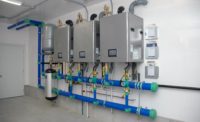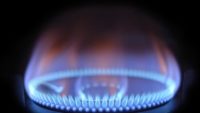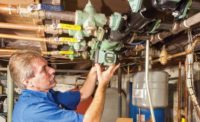According to a report from Global Market Insights, the U.S. boiler market is projected to reach $4.5 billion by 2025, a 3.3% increase since 2018. The demand for boiler systems is increasing due to benefits, such as low fuel consumption and high-energy efficiency, the report notes. PM Engineer reached out to a number of industry experts to see what key trends are shaping this industry and where it is heading in the near future.
Condensing boilers are here to stay
John Miller, senior product manager, commercial boilers, Weil-McLain, notes the overall trend in the market is the transition from non-condensing to condensing boiler designs.
“Condensing is ultimately more efficient because it runs at a lower temperature,” Miller says. “But that trend has been in process for the last 10 years. Moving forward, it's still happening, and it's driven by the Department of Energy (DOE), and the minimum regulations program for the commercial boiler market — the last one was in 2012 with the next one coming up in 2023.”
John Kopf, product manager – boilers, Navien, agrees, saying, “More than half of all condensing boilers sold for commercial applications are floor standing and the majority of new installations use high-efficiency condensing boilers. The trend of switching from non-condensing to condensing boilers will continue into foreseeable future. The continued growth of condensing boilers at the expense of non-condensing is driven by the higher costs of energy and environmental concerns.”
Controls and connectivity
Another big trend is controls technology, Miller notes.
“If you go to the AHRI show every year, you see a lot of differentiation by manufacturers on controls,” he says. “It’s a statement of the times, going from the old guard boiler guys with mechanical controls to the new guard — the next generation of boiler controls. They’re more tech savvy. That would be the second largest trend — the movement from mechanical or what I could call light digital controls to really advanced controls, such as touch screen controls, better diagnostics, service reminders, remote monitoring and more.”
Kopf also points to controls as a trend influencing manufacturer boiler design.
“A growing trend is the BMS connectivity with mechanical equipment using Modbus, BACnet or LonWorks communications protocols,” he says. “In addition to these protocols, 4-20 mA and 0-10 VDC signals are often used to control input and output from boilers. Additionally, the new products being launched come with space saving designs, cascading capabilities, common venting and smart controls.
“Building managers want to be able to control their equipment from anywhere and whenever they need to,” Kopf adds. “They depend on instant alarm notifications and ability to control their assets remotely. The new and much improved controls help contractors speed the installation process, lower installation costs and avoid costly mistakes.”
Sal Brunetto, national sales manager for residential boilers at Bosch Thermotechnology North America, notes that connectivity is driving everything at Bosch.
“We’re really focused on the Internet of Things and what younger customers, the next wave of customers, are truly looking for is being able to connect everything — HVAC and heating equipment is really no different. They’re looking for the ability to monitor what their product is doing. They want to have remote capabilities, just like you would expect with air conditioning systems and some advanced water heaters.”
Emissions, combustion and electrification
According to Nery Hernandez, senior product manager — hydronic solutions, AERCO, the top three trends in the boiler market are combustion process optimization, efficiency and common venting.
“The main factor is an increased desire for boiler efficiency and a better understanding of how to achieve optimal boiler efficiency,” Hernandez says. “The need to control expenses is a key driver for common venting, which is a method to save on venting and installation costs.”
Lyndal Moore, national sales manager, commercial division, Raypak, points to electrification and decarbonization as the biggest trend shaping the boiler market.
“As concerns with climate change have risen to the forefront of engineers’ minds, over the last decade, we have seen a break from traditional system design and technology to more of an appetite for non-conventional systems,” he says. “VRF, heat pump, solar, as well as hydrogen technology, are all part of a boutique technology wave. As new as some of these technologies seem, most have been around for a while, along with the benefits, there are some inherent weaknesses. In the rush to adopt these new technologies, engineers are discovering there is not one perfect technology. Therefore, there will be a pendulum shift (and there already is) back toward hybrid systems, combining the latest non-conventional equipment with the conventional.
“Controls that will harness each technologies’ strengths while negating their weaknesses will be the key part of this endeavor,” Moore adds. “If climate change impact is the No. 1 goal, this will be the quickest way to achieving results. With high-efficiency gas boilers operating in the 90% plus efficiency range, this proven technology is poised to be an important long-term part of the equation and a short-term answer.”
Brunetto also sees electrification as a growing industry trend, along with high-efficiency and connectivity.
“We're looking at an overwhelming force in the marketplace with government influence to get away from combustion products, from both the standpoint of emissions, as well as the actual fuel delivery and the different fuel,” he says. “So when we're looking at combustion, we're looking at oil, propane and natural gas. All of those fuels have a lot of baggage in terms of delivery, in terms of an environmental impact and carbon footprint.”
Brunetto notes boilers can be in service up to 25 years, and unfortunately, they are rarely tested and recertified. The government realizes there are all these unregulated emitters around the country, so now there is a tremendous push towards electrical units rather than fossil fuel burning units.
“That creates a very important change in the trajectory of boilers and hydronic boilers in the U.S., and HVAC products in particular, as we look to the future,” he adds.
The efficiency factor
Miller says DOE regulations definitely drive product design. He notes that 2012 was the last regulatory period on the commercial side. However, DOE issued a final rule at the end of 2016 updating standards for commercial boilers, but delayed final publication in the Federal Register until Jan. 10 of this year. The new minimum efficiency standards will take effect Jan. 10, 2023. For water boilers, efficiencies will increase from 82% to 86%; and for steam boilers, efficiencies will increase from 79% to 84%.
“If you want to play in the market, you have to meet a minimum efficiency,” Miller says.
Boiler efficiencies have been moving to higher levels over the last few years, and nowadays, leading commercial boilers offer up to 97.5% thermal efficiency levels, contributing to substantial operating savings, Kopf notes.
“The boiler efficiency is one of the critical factors when it comes to new product design,” he says. “It has critical impact on the design of the heat exchanger and often is one of the key features mentioned in the typical engineering specification. Manufacturers often target higher efficiency level to proactively target future legislative changes.”
According to Moore, most of the efficiency gains we’re seeing in boilers — no matter the manufacturer — has minimal impact at this point.
“We have boilers running at 97% efficiency, as do our competitors,” he says. “At these levels, improvement gains on ROI are minimal. My concern would be that, in chasing fractional efficiency improvement, there could be impacts on equipment longevity. No matter what technology is being used, equipment longevity cannot be overlooked in any effort of true carbon footprint reduction.”
That being said, Moore also notes federal regulations have traditionally made products better and smarter.
“Often driven by a regulations time component, companies must focus on new product development,” he adds. “The Raypak XVers and MVB products were spurred on in this manner. However, regulations can also hinder product design and best offerings. Hybrid technologies may, in fact, be one of the best current options for reducing carbon footprint in buildings within the constraints of the grid infrastructure and equipment costs. However, some governing regulations are not accounting for hybrid technology applications, or allowing for staging of current to new technology; preventing application of solutions with the most impact, which may stagnate some great technological developments.”
Brunetto agrees, saying boiler technology has been around since the 1800s, and that manufacturers have reached the absolute limit of efficiency.
“We're already at 96% to 97% on our most efficient products, so there's not much more we could do from a standpoint of physics and science,” Brunetto says. “So what has happened as we've sort of tried to race towards the highest efficiency, both on our own and because of government regulation, we've really stretched the limits. So more and more importantly now, a vendor needs to be able to deliver that high efficiency in a dependable way. All of our products are really at that cutting edge of technology. And with that comes high levels of control.
“It really behooves contractors and engineers to talk to their vendors and ask questions — to find out what is next,” he continues. “Because the time will come — it might be next year, it might be two years from now — the products you’re using now might not be available, either because they've been legislated to obsolescence or the manufacturer has moved on. The last oil cast iron boiler will be sold in Boston probably 10 years from now. After that, we’re going to be onto the next thing, such as heat pump technology. In other words, taking heat out of the outdoor environment, putting it into a hydronic system and using electrical technology rather than fossil fuel.”
Looking ahead
The commercial boiler market will see more new boilers featuring advanced controls, including set up wizards, improved connectivity, remote access, predictive maintenance, intuitive displays and integration with renewable heating sources such as solar energy, geothermal, wind and biomass, according to Kopf.
Hernandez notes boilers will continue to have advanced technology to communicate sensory information, such as energy in and out.
“These features will allow facility managers and personnel to know how the boilers in their building are really performing,” he says.
Moore believes the commercial boiler market will be stifled in the short term, due to the current economic situation.
“However, fundamentals are strong,” he says. “As the economy recovers, we will see unbelievable growth opportunities in the coming years. We believe it and we are counting on it.”
Brunetto sees a future market of all electrical products.
“Electrification is something that, as a fuel, is renewable,” he notes. “It’s a fuel that can be created onsite with advances in solar technology. There’s a lot of forces pushing the market that way for a lot of reasons. Contractors and engineers need to be ready. It’s really an exciting time.”
GETTING ENGINEERS’ PERSPECTIVES
John Miller, senior product manager, commercial boilers, Weil-McLain, says feedback from engineering professionals is fundamental for manufacturers.
“Having that relationship with the engineering community — having that rapport, the trust to know your subject matter expert knows the system and knows how important this work is, is critical,” he says. “Boiler systems in the commercial market can become very complicated, and if not done correctly, can be very expensive to fix. So, having a strong, well-trained sales network to guide the engineer is really important.”
John Kopf, product manager – boilers, Navien, notes that working with engineers is absolutely critical.
“One reason is engineers determine which product is specified as base of design and most likely will be the primary choice when it comes to winning the bid,” he says. “Another equally important reason is the specifying engineers have the knowledge and can help manufacturers design winning products.
The so-called voice of customer is extremely important for manufacturers when they are designing new products.” Manufacturers and engineers must work together to produce the best performing real-world systems, notes Nery Hernandez, senior product manager — hydronic solutions, AERCO.
“In a word, engineers are critical,” says Lyndal Moore, national sales manager, commercial division, Raypak. “We constantly solicit feedback from the engineering community. We strive to stay in tune with their challenges and needs. As the market changes and trends evolve, we must keep up with their needs at a minimum, and at best, stay ahead of them.
Sal Brunetto, national sales manager for residential boilers at Bosch Thermotechnology North America, says the success of the manufacturer depends on its outreach ability and capability to impact and engage the engineering community.
“We're always looking at educating the engineering community — keeping them educated and certified,” he says. “We try to keep them updated on not only our products, but the industry in general, where’s the industry going? What is next? What do you need to know? — where is it going and what is coming next. Nowadays, we’ve adapted to doing that on digital platforms with webinars and training over conference calls. There’s also a disparity in the knowledge level from engineers all the way down to the mechanical contractors and plumbers, and we really need to cater to all levels. That’s what a good manufacturer is always going to be focused on doing.”







